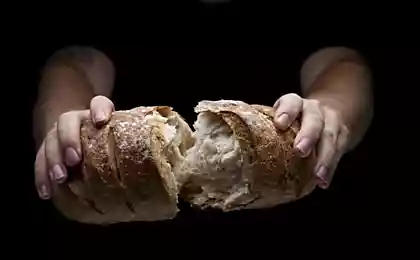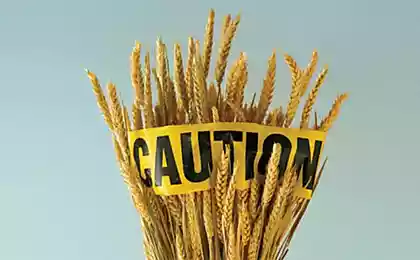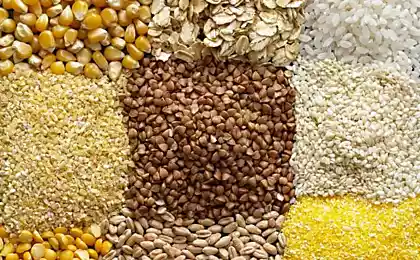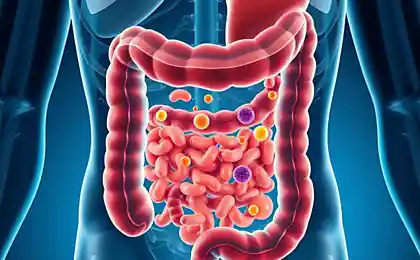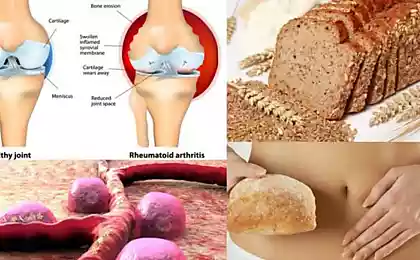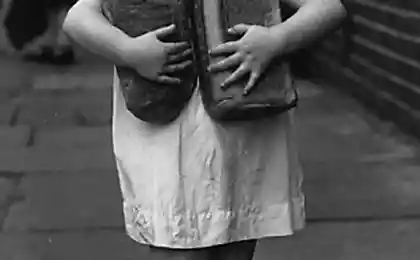215
Therapeutic gluten-free diet - what are the benefits
The main goal of this therapeutic gluten-free diet is to negate the signs of allergies in people suffering from gluten intolerance or gluten allergy. However, many choose this diet simply because avoiding gluten-containing foods (mostly flour and sweet) is also a way to lose weight.
Who started it first?
The concept of “celiac disease” entered the medical lexicon at the end of the XIX century. So began to call chronic intestinal disorder, provoked by several edible types of cereals (wheat, rye, oats, barley) because of the gluten protein contained in them.
At the same time, the first options for a therapeutic diet for people with celiac disease appeared. Today, this diet is shown to every hundredth resident of the United States and Europe with gluten intolerance syndromes (often occurring diarrhea, flatulence and bloating, signs of exhaustion and vitamin deficiency, a sharp slowdown in growth and development in children).
What is the point?
Flour is completely excluded from the diet and most cereals are the main sources of gluten.
How does the diet work?
Foods such as rye, wheat, barley, 80% consist of gluten protein. This protein, or rather, its particles, moving along the small intestine, can damage the villi on the surface of its mucous membrane. Villi help to promote food in the intestines and contribute to its absorption. Excluding products containing gluten from the diet, you strengthen the villi and, as a result, normalize the work of the gastrointestinal tract.
How do you go?
Getting nutrition advice from a doctor is less than half the case. It is important to learn to stick to them and at the same time not to feel deprived. Carefully read the ingredients on product labels. Keep an eye out for new information about gluten and adjust your lifestyle based on other people’s experiences.
Diversify the menu, especially at first, will help gluten-free pasta and cereals, bread and pastries, breakfast cereals and porridge.
What's wrong?
Anything that contains wheat, rye, oats or barley. Under the ban not only flour and cereals (including manca, barley), but also starch, which is part of sausage and dairy products (some yogurt, cottage cheese), tomato sauce, drinks such as cocoa and instant coffee. Juices, corn flakes and sweets (may contain malt extract) are also excluded.
What can I do?
Rice, corn, buckwheat, millet, as well as amaranth and quinoia (these so far exotic Latin American cereals do not contain gluten) and their processed products. Natural meat, fish, eggs, butter, all vegetables and fruits, vegetable oil (sunflower, corn, olive, soy), natural teas, coffee and cocoa.
How many times a day should I eat?
Four to five, the last meal - no later than 18 hours.
Duration and outcome
Constantly adhere to a diet is necessary not only to relieve the painful condition, but also to ensure the full development of the body (if gluten intolerance affects the child). At the age of 12-19 years, many symptoms may disappear, complete remission is possible, but you should not abandon the diet - the disease can return.
Example menu for the week
Monday.
Breakfast
Cheese dessert with fruits, rice breads, honey, cocoa
Lunch
Soup of cauliflower with sour cream, fish in Polish, mashed potatoes, green salad, compote of fruits or berries
Afternoon
Corn flour bun with jam, tea
Dinner.
millet porridge with dried fruits and nuts, kefir (can be replaced with fermented, yogurt or bifid products)
Tuesday.
Breakfast Rice porridge with fruits or berries, corn flour buns, coffee with milk Lunch Meat borsch, gluten-free pasta with sauce of spinach and cheese, meatballs, tea, marmalade Lunch Fruit salad with nuts, rice breads Dinner Buckwheat porridge with milk (in the first year after the diagnosis is better to use cow's milk), corn bread with butter
Wednesday.
Breakfast Omlet with cheese, gluten-free bread, cocoa Meat Lunch or chicken broth with rice, buckwheat flour pancakes with meat, Morse Poldnik Banana baked with chocolate, tea Dinner Stewed vegetables with sour cream, juice
Thursday
Breakfast Cornflakes with milk or juice, fruits Lunch Fish soup, beans in tomato, stew, green salad, compote Lunch Baked apple, nuts, cocoa Dinner Cheese casserole with rice flour, tea
Friday.
Breakfast Salad of grated carrots, raisins and nuts with vegetable oil, grilled cheese in corn breading, kefir Lunch mashed with spinach and cheese (you can add shrimp or nuts), baked chicken fillet with boiled potatoes, salad of cucumbers and tomatoes, juice Cooked egg with chopped herring, Morse Dinner Potato fries with rice flour, tea
Saturday
Breakfast of buckwheat flour with honey and sour cream, kefir Lunch of fresh cabbage, patty with boiled rice, compote Poldnik Fruit jelly or marmalade, corn breads, juice Dinner Salat of boiled beets with garlic and sour cream, bun of rice flour, cocoa
Sunday
Breakfast Cheese with potato starch, coffee with milk Lunch Soup with meatballs, pilaf, salad of celery with an apple, Morse Lunch Apple nut gingerbread, cocoa Dinner Baked potatoes with brynza, tea
Cons:
The diet is diverse, balanced, contains a minimum of high-calorie flour and sweet foods, so it helps to easily lose weight.
Author: Irina Kelner
P.S. And remember, just by changing your consciousness – together we change the world!
Join us on Facebook, VKontakte, Odnoklassniki
Source: www.jv.ru/food/diiety/16207-bezglyutenovaya-dieta.html
Who started it first?
The concept of “celiac disease” entered the medical lexicon at the end of the XIX century. So began to call chronic intestinal disorder, provoked by several edible types of cereals (wheat, rye, oats, barley) because of the gluten protein contained in them.
At the same time, the first options for a therapeutic diet for people with celiac disease appeared. Today, this diet is shown to every hundredth resident of the United States and Europe with gluten intolerance syndromes (often occurring diarrhea, flatulence and bloating, signs of exhaustion and vitamin deficiency, a sharp slowdown in growth and development in children).
What is the point?
Flour is completely excluded from the diet and most cereals are the main sources of gluten.
How does the diet work?
Foods such as rye, wheat, barley, 80% consist of gluten protein. This protein, or rather, its particles, moving along the small intestine, can damage the villi on the surface of its mucous membrane. Villi help to promote food in the intestines and contribute to its absorption. Excluding products containing gluten from the diet, you strengthen the villi and, as a result, normalize the work of the gastrointestinal tract.
How do you go?
Getting nutrition advice from a doctor is less than half the case. It is important to learn to stick to them and at the same time not to feel deprived. Carefully read the ingredients on product labels. Keep an eye out for new information about gluten and adjust your lifestyle based on other people’s experiences.
Diversify the menu, especially at first, will help gluten-free pasta and cereals, bread and pastries, breakfast cereals and porridge.
What's wrong?
Anything that contains wheat, rye, oats or barley. Under the ban not only flour and cereals (including manca, barley), but also starch, which is part of sausage and dairy products (some yogurt, cottage cheese), tomato sauce, drinks such as cocoa and instant coffee. Juices, corn flakes and sweets (may contain malt extract) are also excluded.
What can I do?
Rice, corn, buckwheat, millet, as well as amaranth and quinoia (these so far exotic Latin American cereals do not contain gluten) and their processed products. Natural meat, fish, eggs, butter, all vegetables and fruits, vegetable oil (sunflower, corn, olive, soy), natural teas, coffee and cocoa.
How many times a day should I eat?
Four to five, the last meal - no later than 18 hours.
Duration and outcome
Constantly adhere to a diet is necessary not only to relieve the painful condition, but also to ensure the full development of the body (if gluten intolerance affects the child). At the age of 12-19 years, many symptoms may disappear, complete remission is possible, but you should not abandon the diet - the disease can return.
Example menu for the week
Monday.
Breakfast
Cheese dessert with fruits, rice breads, honey, cocoa
Lunch
Soup of cauliflower with sour cream, fish in Polish, mashed potatoes, green salad, compote of fruits or berries
Afternoon
Corn flour bun with jam, tea
Dinner.
millet porridge with dried fruits and nuts, kefir (can be replaced with fermented, yogurt or bifid products)
Tuesday.
Breakfast Rice porridge with fruits or berries, corn flour buns, coffee with milk Lunch Meat borsch, gluten-free pasta with sauce of spinach and cheese, meatballs, tea, marmalade Lunch Fruit salad with nuts, rice breads Dinner Buckwheat porridge with milk (in the first year after the diagnosis is better to use cow's milk), corn bread with butter
Wednesday.
Breakfast Omlet with cheese, gluten-free bread, cocoa Meat Lunch or chicken broth with rice, buckwheat flour pancakes with meat, Morse Poldnik Banana baked with chocolate, tea Dinner Stewed vegetables with sour cream, juice
Thursday
Breakfast Cornflakes with milk or juice, fruits Lunch Fish soup, beans in tomato, stew, green salad, compote Lunch Baked apple, nuts, cocoa Dinner Cheese casserole with rice flour, tea
Friday.
Breakfast Salad of grated carrots, raisins and nuts with vegetable oil, grilled cheese in corn breading, kefir Lunch mashed with spinach and cheese (you can add shrimp or nuts), baked chicken fillet with boiled potatoes, salad of cucumbers and tomatoes, juice Cooked egg with chopped herring, Morse Dinner Potato fries with rice flour, tea
Saturday
Breakfast of buckwheat flour with honey and sour cream, kefir Lunch of fresh cabbage, patty with boiled rice, compote Poldnik Fruit jelly or marmalade, corn breads, juice Dinner Salat of boiled beets with garlic and sour cream, bun of rice flour, cocoa
Sunday
Breakfast Cheese with potato starch, coffee with milk Lunch Soup with meatballs, pilaf, salad of celery with an apple, Morse Lunch Apple nut gingerbread, cocoa Dinner Baked potatoes with brynza, tea
Cons:
The diet is diverse, balanced, contains a minimum of high-calorie flour and sweet foods, so it helps to easily lose weight.
Author: Irina Kelner
P.S. And remember, just by changing your consciousness – together we change the world!
Join us on Facebook, VKontakte, Odnoklassniki
Source: www.jv.ru/food/diiety/16207-bezglyutenovaya-dieta.html
Drink this beverage every day and You will forget about drugs!
What's the difference? About women under 40 and men over 20

